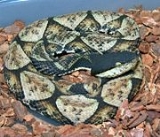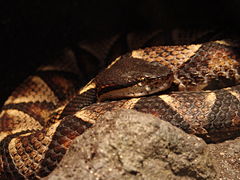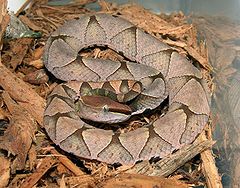
Deinagkistrodon
Encyclopedia
- Common names: sharp-nosed viper, snorkel viper, hundred pacer, Chinese moccasin. more.
Deinagkistrodon is a monotypic
Monotypic
In biology, a monotypic taxon is a taxonomic group with only one biological type. The term's usage differs slightly between botany and zoology. The term monotypic has a separate use in conservation biology, monotypic habitat, regarding species habitat conversion eliminating biodiversity and...
genus
Genus
In biology, a genus is a low-level taxonomic rank used in the biological classification of living and fossil organisms, which is an example of definition by genus and differentia...
created for a venomous
Venomous snake
"Poisonous snake" redirects here. For true poisonous snakes, see Rhabdophis.Venomous snakes are snakes which have venom glands and specialized teeth for the injection of venom...
pitviper
Crotalinae
The Crotalinae, commonly known as "pit vipers" or crotaline snakes, are a subfamily of venomous vipers found in Asia and the Americas. They are distinguished by the presence of a heat-sensing pit organ located between the eye and the nostril on either side of the head...
species
Species
In biology, a species is one of the basic units of biological classification and a taxonomic rank. A species is often defined as a group of organisms capable of interbreeding and producing fertile offspring. While in many cases this definition is adequate, more precise or differing measures are...
, D. acutus, found in Southeast Asia
Southeast Asia
Southeast Asia, South-East Asia, South East Asia or Southeastern Asia is a subregion of Asia, consisting of the countries that are geographically south of China, east of India, west of New Guinea and north of Australia. The region lies on the intersection of geological plates, with heavy seismic...
. No subspecies are currently recognized.
Description

The color pattern consists of a grayish or reddish brown ground color overlaid with a series of brown or reddish brown lateral triangles with grey or beige centers. These join middorsally giving the appearance of alternating triangles of different colors. The head is dark brown on top and beige or pinkish on the sides.
Common names
Sharp-nosed viper, snorkel viper, hundred pacer, Chinese moccasin. Chinese copperhead, five-pacer, hundred-pace snake, long-nosed pit viper, sharp-nosed pit viper, hundred-pace pitviper.Geographic range
Found in southern ChinaChina
Chinese civilization may refer to:* China for more general discussion of the country.* Chinese culture* Greater China, the transnational community of ethnic Chinese.* History of China* Sinosphere, the area historically affected by Chinese culture...
(Chekiang
Zhejiang
Zhejiang is an eastern coastal province of the People's Republic of China. The word Zhejiang was the old name of the Qiantang River, which passes through Hangzhou, the provincial capital...
, Fukien
Fujian
' , formerly romanised as Fukien or Huguing or Foukien, is a province on the southeast coast of mainland China. Fujian is bordered by Zhejiang to the north, Jiangxi to the west, and Guangdong to the south. Taiwan lies to the east, across the Taiwan Strait...
, Hunan
Hunan
' is a province of South-Central China, located to the south of the middle reaches of the Yangtze River and south of Lake Dongting...
, Hupeh
Hubei
' Hupeh) is a province in Central China. The name of the province means "north of the lake", referring to its position north of Lake Dongting...
, Kwantung
Guangdong
Guangdong is a province on the South China Sea coast of the People's Republic of China. The province was previously often written with the alternative English name Kwangtung Province...
), Taiwan
Taiwan
Taiwan , also known, especially in the past, as Formosa , is the largest island of the same-named island group of East Asia in the western Pacific Ocean and located off the southeastern coast of mainland China. The island forms over 99% of the current territory of the Republic of China following...
, northern Vietnam
Vietnam
Vietnam – sometimes spelled Viet Nam , officially the Socialist Republic of Vietnam – is the easternmost country on the Indochina Peninsula in Southeast Asia. It is bordered by China to the north, Laos to the northwest, Cambodia to the southwest, and the South China Sea –...
, and possibly Laos
Laos
Laos Lao: ສາທາລະນະລັດ ປະຊາທິປະໄຕ ປະຊາຊົນລາວ Sathalanalat Paxathipatai Paxaxon Lao, officially the Lao People's Democratic Republic, is a landlocked country in Southeast Asia, bordered by Burma and China to the northwest, Vietnam to the east, Cambodia to the south and Thailand to the west...
. The type locality was not included in the original description. It was later given as "Wusueh [Wu-hsueh], Hupeh Province, China" by Pratt (1892) and Pope (1935). Listed as "Mountains N. of Kiu Kiang" in the catalogue of the British Museum of Natural History.
Habitat
Found on forested mountainMountain
Image:Himalaya_annotated.jpg|thumb|right|The Himalayan mountain range with Mount Everestrect 58 14 160 49 Chomo Lonzorect 200 28 335 52 Makalurect 378 24 566 45 Mount Everestrect 188 581 920 656 Tibetan Plateaurect 250 406 340 427 Rong River...
slopes, rock-strewn hillsides and brushy valley
Valley
In geology, a valley or dale is a depression with predominant extent in one direction. A very deep river valley may be called a canyon or gorge.The terms U-shaped and V-shaped are descriptive terms of geography to characterize the form of valleys...
s. Occurs at elevations between 100 m and 1,400 m.
Behavior
This species is mostly active at night or in the evening and spends the day coiled in sheltering rock ledges, among fallen leaves or bracken, in hollow logs and other places where its color pattern keeps it camouflaged. When encountered it may appear sluggish at first, but it is capable of striking vigorously when threatened.Reproduction

Venom
Dangerous animals often have exaggerated reputations and this species is no exception. The popular name "hundred pacer" refers to a local belief that, after being bitten, the victim will only be able to walk 100 steps before dying. In some areas, it has even been called the "fifty pacer." Nevertheless, this species is considered dangerous, and fatalities are not unusual. An antivenom is produced in TaiwanTaiwan
Taiwan , also known, especially in the past, as Formosa , is the largest island of the same-named island group of East Asia in the western Pacific Ocean and located off the southeastern coast of mainland China. The island forms over 99% of the current territory of the Republic of China following...
.
Brown (1973) mentions a venom yield of up to 214 mg (dried) and (toxicity) values of 0.04 mg/kg IV, 4.0 mg/kg IP
Peritoneum
The peritoneum is the serous membrane that forms the lining of the abdominal cavity or the coelom — it covers most of the intra-abdominal organs — in amniotes and some invertebrates...
and 9.2-10.0 mg/kg SC.
According to the US Armed Forces Pest Managent Board, the venom is a potent hemotoxin
Hemotoxin
Hemotoxins, haemotoxins or hematotoxins are toxins that destroy red blood cells , disrupt blood clotting, and/or cause organ degeneration and generalized tissue damage. The term hemotoxin is to some degree a misnomer since toxins that damage the blood also damage other tissues...
that is strongly hemorrhagic. Bite symptoms include severe local pain and bleeding that may begin almost immediately. This is followed by considerable swelling, blistering, necrosis, and ulceration. Systemic symptoms, which often include heart palpitations, may occur suddenly and relatively soon after the bite. Because of its body size and large hinged fangs which permit effective delivery of large quantities of venom, victims bitten by this snake should be treated accordingly.

